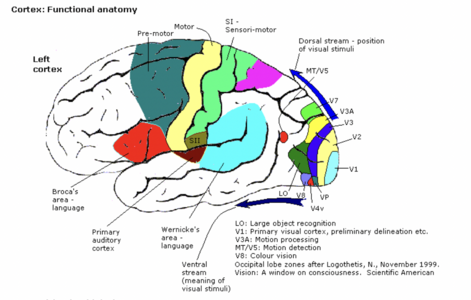Premotor Cortex: Difference between revisions
No edit summary |
No edit summary |
||
| Line 16: | Line 16: | ||
== Physiotherapy Implications == | == Physiotherapy Implications == | ||
[[File:Monkey.jpeg|thumb]] | |||
Damage to premotor cortex may result in | Damage to premotor cortex may result in | ||
Revision as of 02:27, 28 April 2022
Original Editor - Lucinda hampton
Top Contributors - Lucinda hampton and Tolulope Adeniji
Introduction[edit | edit source]
The premotor cortex is a crucial part of the brain, which is believed to have direct control over the movements of voluntary muscles.[1] The PMC is about six times larger than the primary motor cortex[2]. The premotor cortex motor area lies anterior to the primary motor cortex.
The premotor cortex primarily mainly prepares and executes movements of the limbs, through coordination with other parts of the brain in choosing the appropriate motions.
Function[edit | edit source]
The premotor cortex appears to play a role in orienting the body and readying the postural muscles for forthcoming movements. This appears to be the case as the premotor cortex mainly projects to the proximal musculature, with efferent fibers from the premotor cortex serving motor neurons of the trunk and shoulders (predominantly) and it receives inputs important for spatial orientation (from the posterior parietal cortex)[3]. It is especially active when motor routines are run in response to visual or somatic sensory cues, such as reaching for an object in full view or identifying an object out of sight by manipulation.
The ventral and lateral areas anticipate and direct the movements of the body in response to external stimuli (eg visual and audio inputs) whilst the medial area responds to internal stimuli from other parts of the brain (eg memories) and acts as a relay station to execute a particular physical act. It is also important in learning, through the practice of imitation, and skills of social cognition through empathy.[1]
Physiotherapy Implications[edit | edit source]
Damage to premotor cortex may result in
- Apraxia, an acuired inability to carry out skilled actions that could previously be performed (but without paralysis)
- Deficits in contralateral fine motor control, such as the performance of complex serial movements eg In monkeys, lesions of premotor cortex often result in an inability to redirect the paw around the back of a transparent object to reach a food reward. Even with visual feedback indicating that the object is in the way, monkeys with premotor cortex lesions do not recognize the possibility of guiding the paw through an alternative, indirect route[3]
- Difficulty in using sensory feedback for the control and performance of movements.[4]
References[edit | edit source]
- ↑ 1.0 1.1 Bodytomy Premotor cortex Available:https://bodytomy.com/premotor-cortex-location-structure-function (accessed 29.4.2022)
- ↑ Mtui E, Gruener G, Dockery P. Fitzgerald's Clinical Neuroanatomy and Neuroscience E-Book. Elsevier Health Sciences; 2020 Aug 4. Available: https://www.sciencedirect.com/topics/neuroscience/premotor-cortex(accessed 28.4.2022)
- ↑ 3.0 3.1 Rosenbaum DA. Human motor control. Academic press; 2009 Sep 11.Available:https://www.sciencedirect.com/science/article/pii/B978008057108950007X (accessed 29.4.2022)
- ↑ Brown ed Available: Frontalhttps://www.brown.edu/Courses/BI_278/Other/Teaching%20examples/biomed-370/syllabus/5-frontal.pdf (accessed 28.4.2022)








